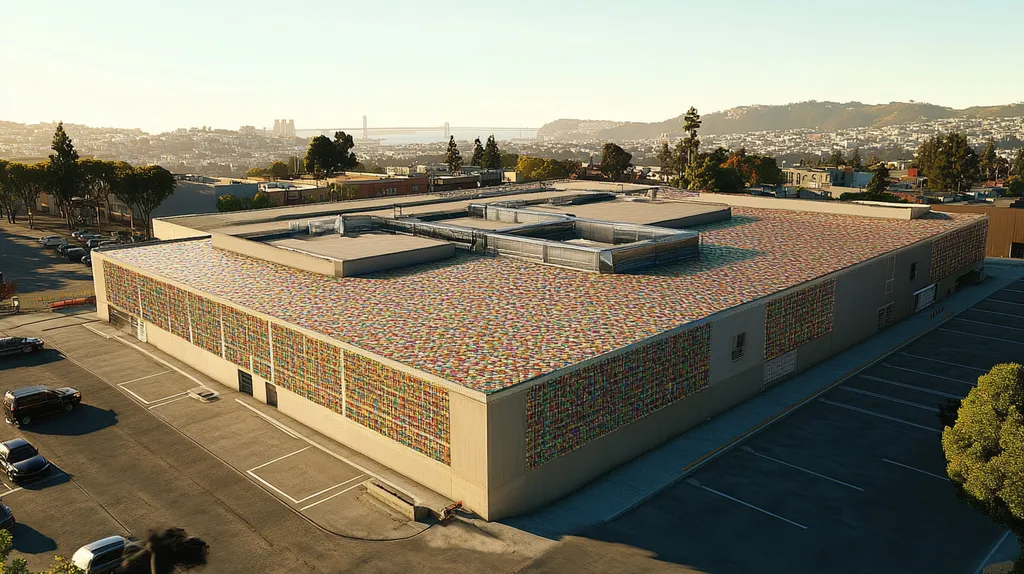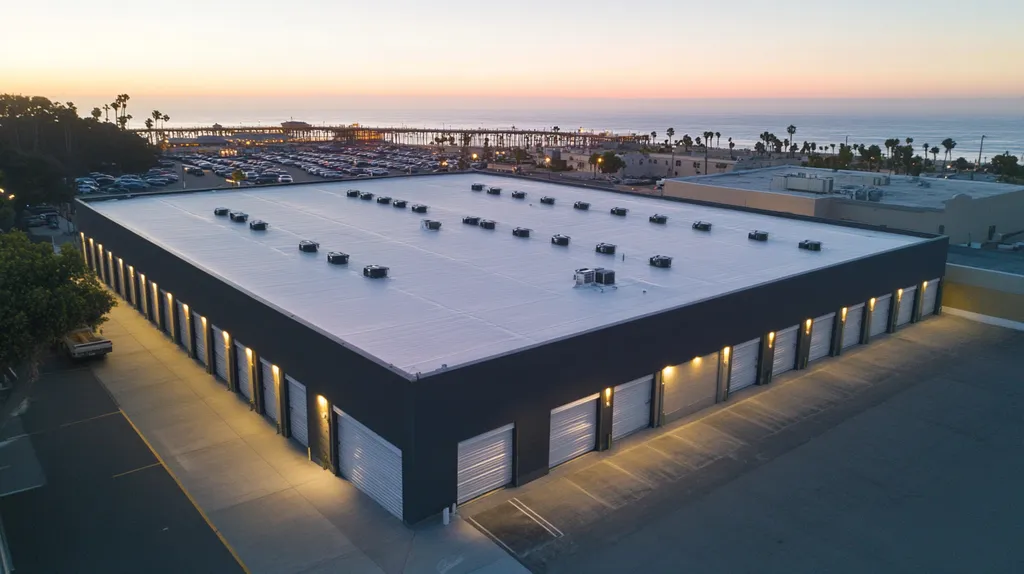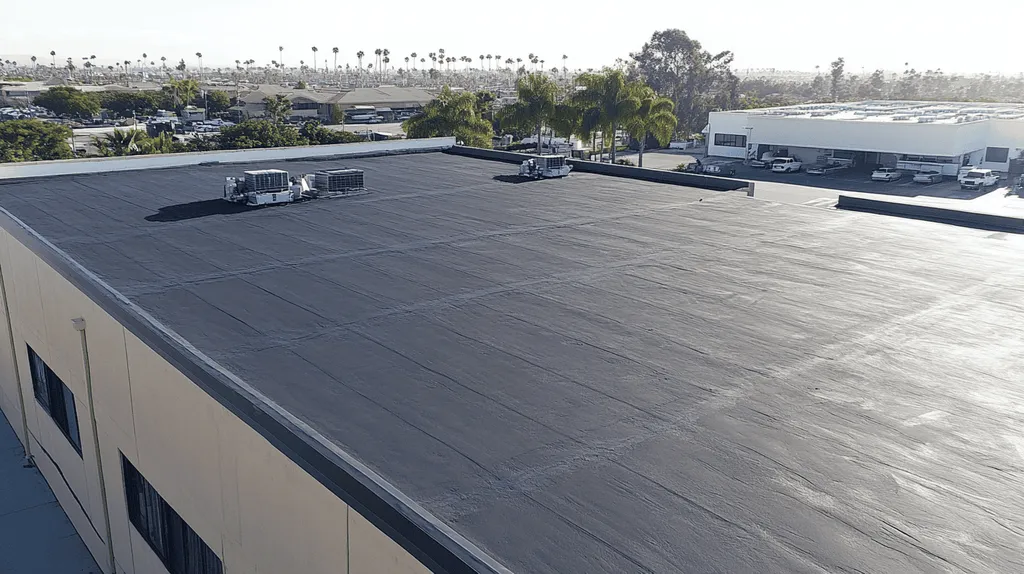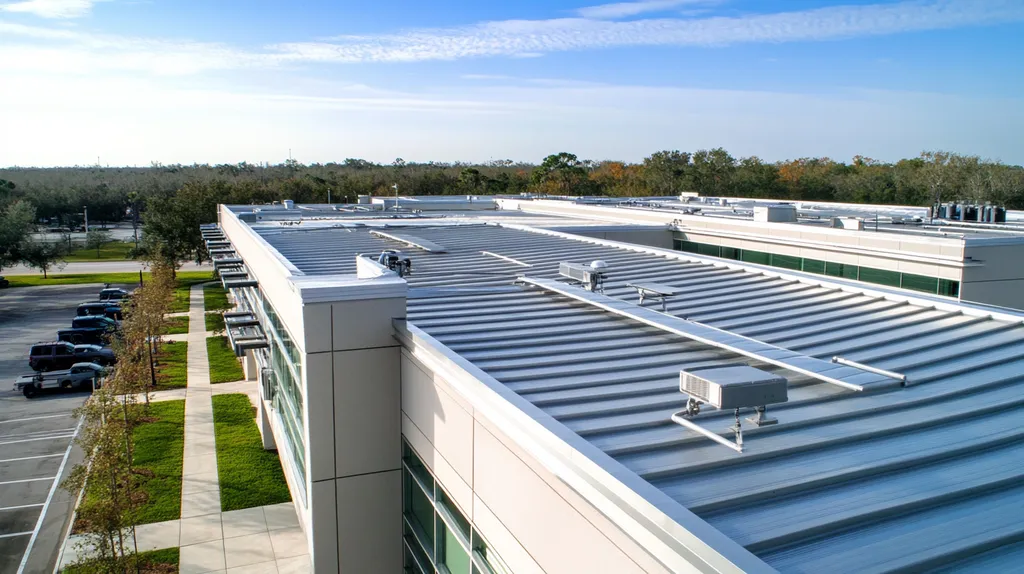Commercial roof maintenance contracts are failing property owners at an alarming rate, with recent studies showing that 40% of all roof failures stem directly from inadequate maintenance compliance. These oversights cost building owners an estimated $2.5 billion annually in preventable repairs.
The traditional approach to maintenance contracts requires urgent reform, as current practices overlook critical factors like climate-specific requirements, advanced inspection technologies, and proper documentation of preventive care.
This analysis examines systemic issues in standard maintenance agreements while providing data-driven solutions to protect valuable roofing assets and ensure regulatory compliance.
SECTION 1: CURRENT PRACTICES
The realm of commercial roof maintenance contracts presents significant challenges that require immediate attention. Alarmingly, recent statistics indicate that 20% of roofs without regular oversight deteriorate faster than expected, resulting in expensive repairs or even total replacements. This reality underscores the necessity for strict compliance in maintenance practices. Property owners and facility managers must grasp the current contractual terms, typical services offered, and inspection schedules to identify improvement opportunities and strengthen the protection of their valuable assets.
Standard Contract Terms and Conditions
Many maintenance contracts prioritize cost savings over quality assurance. Consequently, these agreements frequently lack clear specifications regarding the materials and techniques used for repairs, as well as potential liabilities and adherence to local building codes. This ambiguity can leave property owners vulnerable if roofing issues arise.
Moreover, the fine print often includes unexpected fees for services that should be routine, like emergency repairs. Discrepancies in language and expectations can lead to disputes or interruptions in service, highlighting the pressing need for transparency during contract negotiations.
Often, contracts fail to outline a minimum number of inspections or maintenance visits per year. This omission may encourage a reactive rather than proactive strategy towards roof management, which directly impacts the longevity of the building.
For property owners, understanding the standard terms of these contracts is paramount. A thorough evaluation can illuminate potential compliance gaps that, if neglected, could lead to significant financial repercussions in the future.
Typical Maintenance Services Included
Most standard maintenance contracts provide a basic package of services, usually limited to visual inspections and debris removal. While these procedures are essential, they often fall short of addressing the complexities present in modern roofing systems.
Common practices frequently overlook detailed evaluations of critical components such as flashing, seams, and drainage systems. Skipping comprehensive inspections can hide underlying issues, potentially leading to more severe problems if left unmonitored.
Contractors often market routine maintenance as a preventative measure against leaks and structural failures. However, the definition of “routine” can vary widely among different providers. Insufficient maintenance may result in missed opportunities for timely interventions, ultimately costing property owners more in repairs.
The challenge lies in ensuring that maintenance contracts encompass the full range of services necessary for optimal roof performance. Identifying critical services, rather than merely standard offerings, is vital for protecting investments.
Common Scheduling and Inspection Frequencies
Maintenance contracts typically dictate the scheduling and frequency of roof inspections, often defaulting to bi-annual evaluations that may not suit every building’s unique conditions.
Factors such as geographic location, climate conditions, and roofing materials can greatly affect inspection frequency. For example, roofs situated in areas prone to severe weather may necessitate more frequent assessments to prevent catastrophic failures.
Furthermore, current practices may lack flexibility, binding property owners to inflexible schedules that don’t account for changing circumstances. This rigidity can lead to missed chances for timely maintenance and heightened exposure to damage.
Property owners should be aware of these trends in inspection scheduling. Customizing inspection frequency to suit specific needs can significantly extend a roof’s lifespan and decrease overall maintenance expenditures.
SECTION 2: SYSTEMIC ISSUES
The roofing industry is grappling with serious challenges in maintenance practices that threaten building integrity. Alarmingly, studies reveal that nearly 80% of commercial roofs suffer from issues stemming from inadequate maintenance schedules. These systemic problems not only lead to exorbitant repair costs but also disrupt business operations and tenant safety. It is essential for property owners and facility managers to identify these gaps to safeguard their investments. The key issues at play include insufficient inspection frequencies, lack of customization for local weather conditions, and inadequate training for maintenance teams.
Inadequate Inspection Frequencies and Procedures
Many commercial roofing contracts are based on the assumption that annual inspections are sufficient. This infrequency can be particularly harmful in regions that experience extreme weather, as roof degradation often occurs unnoticed until extensive damage has taken place. Routine inspections ideally should occur at least biannually and immediately after extreme weather events to allow for early detection of issues like cracks, blisters, or water pooling.
Yet, a significant number of property owners fail to follow this crucial maintenance schedule. Furthermore, standard inspection procedures frequently lack the thoroughness required to catch subtle, yet critical, problems. For instance, visual inspections alone can overlook hidden structural issues that may lead to significant leaks if not addressed.
The repercussions of neglecting appropriate inspection frequency can be severe. Delayed maintenance typically results in escalating repair costs and presents potential safety hazards, leaving property owners at risk of substantial financial losses.
Lack of Customization for Local Weather Conditions
Commercial roofing maintenance cannot adopt a one-size-fits-all approach. Unfortunately, many contracts fail to consider local weather patterns, resulting in maintenance strategies that may be ineffective. For instance, roofs in hurricane-prone regions require more frequent assessments due to risks associated with wind uplift and water intrusion.
Customized maintenance should take into account not just the materials used but also the specific actions needed to address the realities of the local environment. A property situated in a snow-heavy climate demands vastly different care than one located in an arid region.
By ignoring the need for tailored maintenance practices, property managers risk premature roof failures. Using inappropriate materials and methods not suited for local elements can accelerate wear and tear, making roofs vulnerable to damage.
The result could be costly replacements or extensive renovations if maintenance isn’t adjusted to align with climate conditions. Hence, keeping roofs suitable for their environmental context is vital for ensuring their longevity.
Insufficient Training for Maintenance Teams
A major oversight within commercial roofing contracts involves the training provided to maintenance teams. Many staff members lack specialized knowledge of roofing materials, installation techniques, and preventive maintenance strategies. Without adequate training, routine maintenance may fail to accomplish its purpose.
Ongoing training enhances a team’s ability to identify problems early and address them effectively. An informed workforce familiar with evolving roofing technologies and materials can significantly reduce the likelihood of roofing failures.
Moreover, inadequately trained teams may inadvertently skip essential maintenance tasks, leading to dire consequences. For example, neglecting to replace worn-out seals can result in leaks, substantially increasing repair costs over time.
Investing in regular education for maintenance teams is indispensable. A well-trained workforce can vastly improve adherence to maintenance protocols, ultimately preserving building integrity and minimizing long-term costs.
SECTION 3: MISSED OPPORTUNITIES
Missed opportunities in commercial roof maintenance contracts can have dire long-term implications. According to the National Roofing Contractors Association, approximately 80% of roofing failures stem from inadequate maintenance practices. This alarming statistic emphasizes the necessity of addressing often-overlooked aspects of roof care to prevent unnecessary expenses and potential damage. Critical issues include the neglect of UV and environmental damage, insufficient seasonal maintenance adjustments, and failure to ensure warranty compliance and renewal.
Failure to Address UV and Environmental Damage
Property owners frequently underestimate how UV rays and environmental factors can impact roofing materials. Over time, exposure to these elements degrades roof membranes, resulting in leaks and structural problems. Regular inspections that include UV exposure evaluations are vital to mitigating extensive damage before it manifests.
When maintenance contracts overlook UV assessments, property owners may unintentionally forfeit valuable warranty protections. Roofs that are designed to endure environmental stress can fail prematurely without appropriate upkeep, leaving facilities exposed to increased financial risks. Neglecting these crucial evaluations can lead to unexpected repair costs, significantly elevating the overall lifecycle expenses.
There are innovative membrane technologies available to enhance UV resistance, yet many maintenance contracts do not capitalize on these advancements. Failing to proactively address UV degradation can lead to reduced roof lifespan, necessitating premature replacements and disrupting operations. By adopting industry best practices, property owners can significantly optimize roof performance and protect their investments.
In summary, addressing UV and environmental damage in maintenance contracts is not merely advantageous; it is essential for long-term viability. Property managers must ensure their roofing contracts incorporate regular assessments and updates to effectively combat these pervasive risks.
Neglect of Seasonal Maintenance Adjustments
Seasonal shifts can dramatically affect a roof’s condition, yet many maintenance contracts do not include necessary seasonal adjustments. Ignoring weather-related impacts can result in missed issues that may escalate into costly repairs. Regular seasonal inspections are crucial to identify and mitigate problems like ice damming or debris accumulation.
For example, heavy snowfall can impose excessive weight on roofs that aren’t properly tested for snow loads, posing serious structural risks. When maintenance contracts fail to outline guidelines for seasonal preparations, property owners face the risk of sudden and unanticipated expenses. Proactive seasonal measures can mitigate these risks and provide peace of mind.
Moreover, overlooking seasonal adjustments may compromise the effectiveness of existing repair strategies. For instance, applying moisture seals in cold weather may not achieve the intended results. A lack of adaptability in maintenance practices can lead to inefficiencies and greater future costs.
Including seasonal adjustments in maintenance contracts boosts roof resilience and aids in long-term sustainability. By proactively addressing seasonal changes, property owners can better protect both their roofs and their investments.
Overlooking Warranty Compliance and Renewal
Warranty compliance and renewal represent critical components for safeguarding long-term roofing investments, yet many property owners overlook this essential aspect. Roof warranties typically have specific maintenance requirements, and failing to adhere to these stipulations can void coverage. Understanding the terms of warranties is vital for maintaining financial protection against roofing failures.
In numerous cases, contractors do not properly emphasize these obligations within maintenance agreements. Consequently, property managers may inadvertently forfeit warranties, exposing themselves to significant replacement costs. Regularly reviewing warranty conditions helps ensure alignment with maintenance practices.
Additionally, proactively planning for warranty renewals can lead to more favorable terms and pricing. Many companies miss renewal deadlines due to oversight, inadvertently losing vital protections. Collaborating with a knowledgeable contractor can help in navigating the complexities of warranty management effectively.
Overall, prioritizing compliance and timely renewal of roofing warranties is essential within maintenance contracts. By doing so, property owners not only safeguard their investments but also enhance the longevity of their roofs.
SECTION 4: ROOT CAUSES
Identifying the root causes of compliance issues in commercial roof maintenance contracts is essential for property owners and facility managers. Shockingly, a significant 30% of commercial roofs fail to operate effectively due to poor maintenance practices. This widespread issue often arises from limited contractor expertise, ineffective communication, and budget constraints. Each of these factors perpetuates a cycle of non-compliance that threatens the integrity of roofing systems and operational efficiency. Understanding these underlying causes is crucial for driving necessary improvements in the industry.
Limited Contractor Expertise and Qualifications
The roofing industry is currently facing an urgent challenge: many contractors lack the requisite expertise to conduct thorough roof maintenance. This knowledge gap frequently results in shallow solutions that fail to address deeper, underlying problems. For example, a contractor may neglect critical spots where leaks typically occur, ultimately causing long-term infrastructure damage.
Moreover, not every contractor is well-versed in the latest roofing materials and technologies. Such a lack of familiarity can lead to improper installation or maintenance practices. When contractors are not updated on industry trends and standards, the likelihood of non-compliance escalates considerably.
Furthermore, some contractors may prioritize speed over quality due to time constraints. Rushed maintenance can lead to essential checks and repairs being bypassed, worsening the roof’s condition over time. A lack of attention to detail during maintenance ultimately jeopardizes the roof’s lifespan and operational efficacy.
To mitigate these risks, property managers should rigorously assess contractor qualifications when selecting service providers. Ensuring that contractors possess relevant certifications and ongoing training is vital for achieving compliance and maintaining the overall integrity of the roof.
Ineffective Communication Between Contractors and Property Managers
Communication breakdowns between contractors and property managers can significantly worsen compliance issues. When expectations aren’t clearly communicated, misunderstandings can arise, complicating maintenance efforts. For instance, if a property manager is unaware of specific maintenance requirements, vital tasks may be overlooked.
The situation is complicated by the intricate nature of commercial roofing systems. Property managers must convey what needs to be done and why it is imperative. If the rationale behind certain maintenance procedures is not well articulated, compliance efforts may falter.
Additionally, delayed communication can result in missed opportunities to address time-sensitive roofing issues. A roof might exhibit early signs of wear, but if these concerns are not communicated swiftly, necessary repairs could be postponed, leading to extensive damage.
Holding regular meetings between contractors and property managers can enhance understanding and alignment regarding goals and expectations. Maintaining open lines of communication is vital to executing maintenance plans effectively and ensuring compliance throughout the process.
Budget Constraints and Cost-Cutting Measures
Budget limitations often compel property managers to adopt minimal maintenance practices, which can lead to compliance failures. Cost-cutting strategies may manifest in reduced inspection frequencies and repairs, allowing minor problems to escalate unchecked. For example, neglecting basic maintenance tasks, such as regularly clearing debris, can result in significant long-term roof damage.
Moreover, property managers may resort to hiring lower-cost contractors to control expenses. Although this approach appears financially beneficial, it can backfire if those contractors lack the necessary skills and experience. The initial savings may rapidly dissipate due to costly repairs prompted by structural failures.
Property managers face the challenge of balancing fiscal responsibility with the need for quality. While investing in a well-structured maintenance contract may seem expensive, it can prove cost-effective over time by prolonging the roof’s lifespan.
Finally, exploring financing options for essential roof maintenance can ease budget constraints. This strategy allows property managers to prioritize compliance without compromising on the quality of service delivered.
DATA DRIVEN EVIDENCE
The stakes in commercial roof maintenance are critical, with potential costs skyrocketing due to neglected upkeep. Ensuring compliance in maintenance contracts can save property owners significant amounts of money while extending the lifespan of their roofs. Research shows that regular maintenance can reduce roofing costs by as much as 30% over the roof’s lifespan. By understanding the data backing these claims, property owners can make informed decisions that positively impact their budgets and preserve the longevity of their properties.
Cost Savings Through Preventive Maintenance
Preventive maintenance plays a pivotal role in managing costs associated with commercial roofing. Properties that invest in regular inspections and maintenance can expect to save between 15% to 30% compared to those that wait for problems to surface. These savings primarily arise from averting costly repairs and replacements that typically result from ignoring minor, manageable issues.
Annual maintenance checks can pinpoint vulnerabilities, such as small leaks or membrane degradation, before they progress into expensive emergencies. For example, a commercial building that invests $1,500 annually in routine maintenance might sidestep a $15,000 emergency repair. This proactive strategy is essential for ensuring long-term financial viability.
Additionally, maintaining thorough records of inspections allows property owners to negotiate more favorable terms in future agreements and budget planning. This data-driven approach fosters a more sustainable financial model, ensuring resources are allocated judiciously.
In summary, prioritizing preventive maintenance not only reduces costs but also optimizes overall roof performance. Therefore, compliance with maintenance contracts should be a top priority for property managers looking to safeguard their financial interests.
Extended Roof Lifespan Statistics
A roof that is not maintained typically has a lifespan of approximately 15 to 20 years, but consistent upkeep can significantly extend this duration. Evidence indicates that roofs with regular maintenance can last up to 30% longer than their poorly maintained counterparts. This prolonged lifespan translates directly into deferred capital expenditures for property owners.
For instance, a 20-year roof may last around 26 years with diligent preventive care. Such an extension alleviates the urgency for premature replacement, conserving financial resources and minimizing disruption to ongoing business operations.
Moreover, a well-documented maintenance history can bolster warranties and potentially lower insurance premiums. Consistent maintenance and accurate records diminish the chances of claims related to premature failure, which can ultimately contribute to lower operational costs over time.
In summary, the evidence strongly supports that a commitment to compliance can enhance the longevity of roofing systems. Recognizing the significant impact of maintenance on roof lifespan empowers property owners to advocate for more robust compliance measures within their contracts.
Reduction in Emergency Repair Incidents
Emergency roof repairs can severely disrupt business operations and generate unexpected financial burdens. Data reveals that properties that engage in scheduled maintenance experience up to 70% fewer emergency incidents, offering significant advantages in operational continuity and financial stability.
When preventive measures are integral to maintenance plans, critical issues can be identified before they escalate into substantial problems. For instance, a commercial facility adhering to a regular upkeep schedule may face emergency repairs only once every five years, compared to facilities that neglect maintenance, which might require immediate repairs multiple times a year.
The financial benefits of reducing emergency repairs are apparent. Property owners can allocate funds that would otherwise be spent on unforeseen expenses towards planned improvements or other essential services, thus fostering a healthier financial landscape and better budget management.
Ultimately, the relationship between compliance and a reduction in emergency repairs underscores the crucial role of proper roof maintenance. By sticking to maintenance contracts, property owners equip their roofs to withstand challenges, protecting both their investments and operational efficiency.
SECTION 6: ALTERNATIVE SOLUTIONS
As the stakes for commercial roof maintenance increase, property owners must reevaluate their strategies. The National Roofing Contractors Association reports that poorly maintained roofs contribute to up to 35% of commercial roofing failures. This alarming statistic highlights the critical need for enhanced compliance with maintenance practices. By exploring alternative solutions, property owners can ensure effective roof upkeep, thereby preserving property value and safety. The following strategies focus on creating tailored maintenance plans, leveraging advanced technologies, and utilizing localized expertise.
Tailored Maintenance Plans for Specific Roof Materials
Recognizing that not all roofs are created equal is essential; a one-size-fits-all approach can be harmful. Maintenance plans must be tailored to specific materials, such as single-ply membranes, metal roofs, or built-up roofing systems, as each type necessitates unique care routines.
For instance, thermoplastic polyolefin (TPO) roofs often require more frequent inspections for UV damage compared to traditional asphalt roofs. By customizing maintenance, property owners can better understand the distinctive vulnerabilities associated with their roofing type.
Furthermore, consistent evaluations of material performance allow for timely adjustments to maintenance frequency and interventions. Targeted strategies will not only extend the life of the roof but also mitigate unexpected repair costs.
By implementing material-specific maintenance plans, property owners fulfill compliance requirements while fostering an active approach to maintaining their roofs.
Implementing Advanced Inspection Technologies
Advancements in technology are revolutionizing roof management, enabling more thorough and efficient inspections. Tools such as drones and thermal imaging cameras provide the capability to swiftly identify issues that may otherwise remain hidden.
Drones, for example, can cover extensive areas more quickly than traditional methods, providing high-resolution images for detailed analysis. This technology aids in detecting concealed leaks or thermal anomalies that indicate insulation challenges.
Moreover, software solutions can record maintenance history and highlight necessary repairs, simplifying compliance documentation. Investing in these innovations allows property owners to enhance the longevity of their roofs while ensuring maintenance contracts remain effective.
Integrating these advanced methods is not merely a trend; it serves as a preventive measure against small problems escalating into significant failures, ultimately conserving resources and reducing costs.
Prioritizing Local and Climate-Specific Expertise
A thorough understanding of regional climates and conditions is vital for effective roof management. Engaging local expertise enables a tailored response to environmental challenges, including high winds, severe storms, or extreme temperatures, which all influence a roof’s performance.
For instance, roofs situated in coastal regions might necessitate different materials or protective measures than those located in arid climates. Collaborating with experts familiar with local characteristics ensures that maintenance strategies are both relevant and practical.
This localized know-how can also aid compliance with building codes and insurance criteria, thereby reducing risks for property owners. It’s crucial to partner with professionals who have insight into the long-term effects of environmental factors on roofing systems.
In conclusion, prioritizing local expertise not only enhances compliance with maintenance practices but also strengthens overall roofing strategies, ultimately securing investments and ensuring safety.
The Bottom Line
With 40% of commercial roof failures directly linked to inadequate maintenance compliance, the industry stands at a critical crossroads.
Traditional maintenance contracts have proven insufficient in addressing modern roofing challenges, leading to $2.5 billion in preventable annual repairs.
The evidence demonstrates that properties implementing comprehensive maintenance programs experience 30% longer roof lifespans and 70% fewer emergency repairs.
Success requires abandoning the one-size-fits-all approach in favor of data-driven, climate-specific maintenance strategies supported by advanced inspection technologies.
Without immediate reform in contract practices and compliance standards, property owners will continue facing escalating costs and premature roof failures that threaten both their investments and building occupant safety.
FREQUENTLY ASKED QUESTIONS
Q. What are the current practices in commercial roof maintenance contracts?
A. Current practices often focus on cost-saving rather than comprehensive maintenance, leading to vulnerabilities. Many contracts lack specific terms related to inspections and repairs, which can jeopardize roof integrity. Understanding these terms helps property owners avoid compliance pitfalls.
Q. How do systemic issues affect industrial roof maintenance?
A. Systemic issues like inadequate inspections and lack of contractor training can contribute to persistent problems. Approximately 80% of roofs experience issues from insufficient maintenance that can escalate costs and pose safety risks. Identifying these gaps is crucial for effective roof management.
Q. What are common missed opportunities in commercial roofing?
A. Common missed opportunities include neglecting UV damage and failing to conduct seasonal adjustments. Approximately 80% of roofing failures arise from inadequate maintenance practices, which greatly emphasizes addressing these often-overlooked aspects to protect investments.
Q. What root causes lead to compliance issues in commercial roofing?
A. Root causes include limited contractor expertise, ineffective communication, and budget constraints. These factors can perpetuate non-compliance, compromising the integrity of roofing systems and leading to significant financial losses for owners.
Q. How can data drive compliance in commercial roof maintenance?
A. Data indicates that regular maintenance can reduce roofing costs significantly while extending lifespan. Investing in preventive maintenance enables property owners to avoid emergency repairs, leading to substantial savings and optimized roof performance.
Q. What alternative solutions enhance commercial roof maintenance?
A. Alternative solutions include tailored maintenance plans and the use of advanced technologies. Customizing strategies for specific roofing materials and utilizing tools like drones can improve inspection accuracy and compliance, ultimately safeguarding investments.
Q. Why is warranty compliance crucial for commercial roofs?
A. Warranty compliance ensures that maintenance aligns with terms set by manufacturers, protecting owners from premature failures. Failing to adhere can void coverage, exposing property managers to costly repairs and loss of financial protection.









